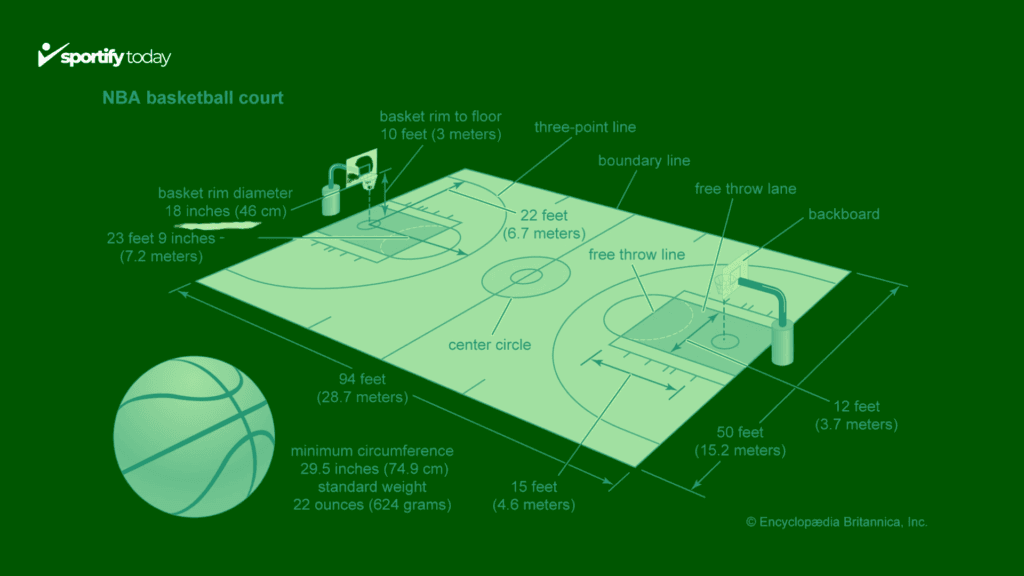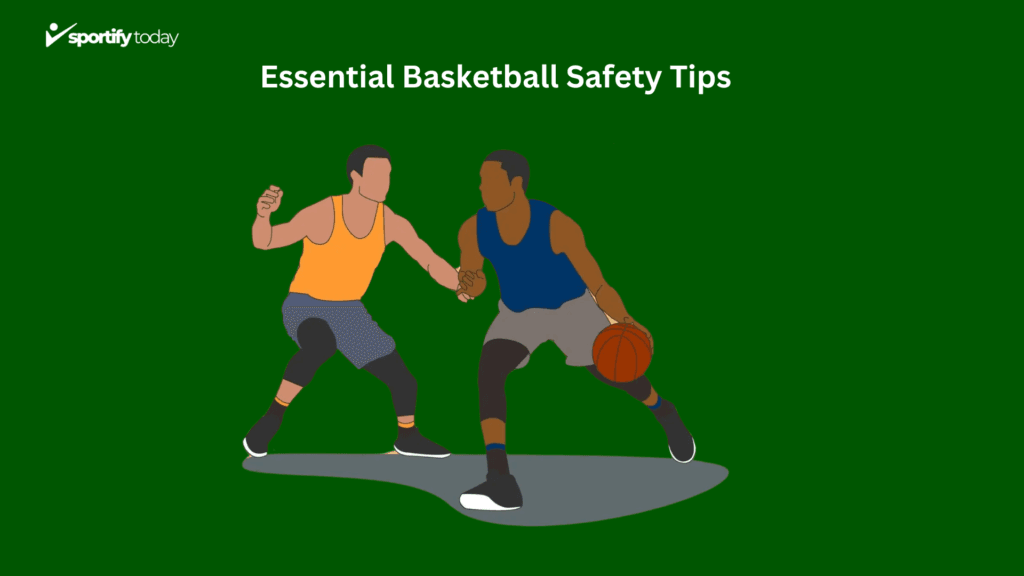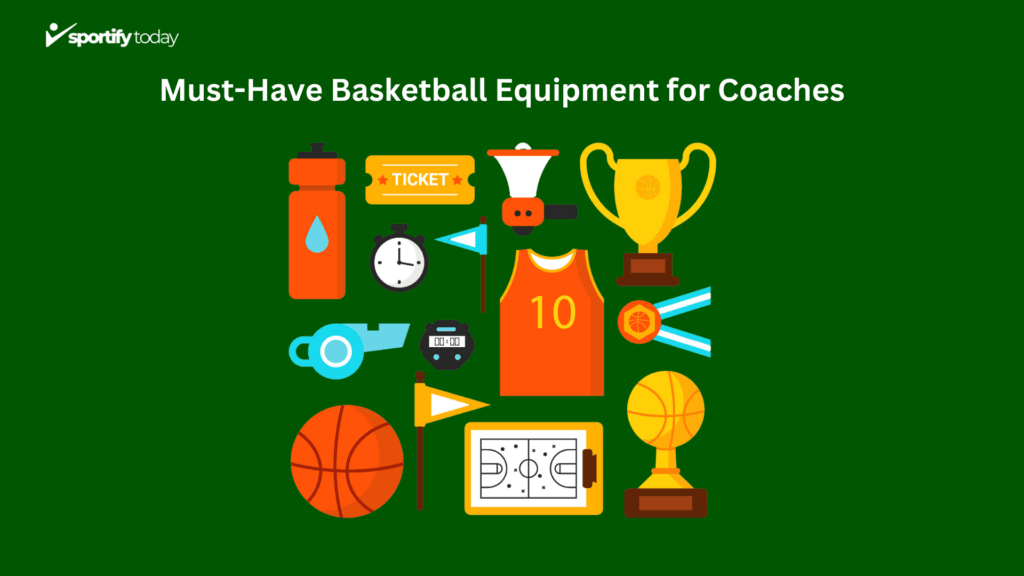
Introduction : Basketball is a sport that requires specialized equipment to ensure player safety, comfort, and optimal performance. Whether you’re a seasoned player or just starting out, it’s important to have the right gear to fully enjoy the game. Here are some Sports Equipment For Basketball Players items every player should consider to play.
Equipment Needed for Basketball

| Basketball | The primary equipment for dribbling, passing, and shooting. |
| Basketball Hoop | Essential for shooting, includes the backboard and rim. |
| Basketball Shoes | Provide ankle support and grip to reduce injury risk. |
| Practice Jerseys | Breathable clothing worn during practice for ease of movement. |
| Water Bottle | To stay hydrated during games and practices. |
| Whistle | Used by referees or coaches to signal stoppages or fouls. |
Basketball is a sport that requires specialized equipment to ensure player safety, comfort, and optimal performance. Whether you’re a seasoned player or just starting out, it’s important to have the right gear to fully enjoy the game. Here are some essential basketball equipment items every player.
1. Basketball
The most crucial piece of equipment is, of course, the basketball itself. Choose a ball that is appropriate for your age, gender, and skill level. The standard size for men is 29.5 inches, while women use a 28.5-inch ball. Beginners may want to start with a slightly smaller ball for better control.
2. Basketball Shoes
Investing in a good pair of basketball shoes is essential for comfort, support, and traction on the court. Look for shoes with ample cushioning, ankle support, and a non-marking rubber sole. Avoid wearing regular sneakers, as they may not provide the necessary support and grip.
3. Athletic Clothing
Wear comfortable, breathable clothing that allows for easy movement. Opt for moisture-wicking fabrics to keep you dry during intense gameplay. Shorts or compression pants and a lightweight t-shirt or jersey are ideal choices.
4. Basketball Hoop
A basketball hoop consists of a backboard, rim, and net. The standard backboard size is 6 feet tall by 3.5 feet wide, made of tempered glass, acrylic, or fiberglass. The rim is 18 inches in diameter and set at a height of 10 feet from the playing surface. The net is typically 15 inches long and made of nylon or other synthetic materials.
5. Basketball Court
A regulation basketball court measures 94 feet long by 50 feet wide, with a free-throw line 15 feet from the basket. The court should have a smooth, non-slip surface suitable for basketball gameplay.
6. Mouthguard
While not mandatory, wearing a mouthguard can help protect your teeth in case of accidental collisions or falls. Custom-fitted mouthguards offer the best protection.
7. Knee or Ankle Braces
If you have a history of knee or ankle injuries, consider wearing braces or sleeves for added support and stability. This can help prevent further injury during gameplay.
8. Gym Bag
A sturdy gym bag is essential for carrying all your basketball gear to and from the court. Look for a bag with separate compartments for your shoes, clothes, and other items. Remember, the right equipment can enhance your performance and reduce the risk of injury. Invest in quality gear that fits well and provides the necessary support and comfort for your basketball journey.
7. Basketball
The basketball itself is the most fundamental piece of equipment. Choose a ball that suits your level of play, whether it’s a standard size 29.5 inches for men or 28.5 inches for women. Look for a high-quality ball made of durable materials that provide good grip and control.
8. Basketball Shoes for Outdoor Play
Investing in a good pair of basketball shoes is vital, especially for outdoor play. Look for shoes that offer excellent traction, cushioning, and ankle support to withstand the rigors of outdoor surfaces. Ensure they are made from breathable materials to keep your feet comfortable during intense games.
9. Basketball Hoop
A sturdy basketball hoop is essential for practice and gameplay. Look for a hoop with a breakaway rim, which flexes upon impact to prevent damage and reduce injury risk. Ensure the hoop is adjustable if you’re training with younger players or need to practice different shot heights.
10. Cones & Agility Ladders
Training aids like cones and agility ladders are excellent for developing footwork, speed, and agility. Use cones to set up drills that enhance dribbling skills, while agility ladders can improve quickness and coordination, essential for effective movement on the court.
11. Shooting Machine
If you’re serious about improving your shooting skills, a shooting machine can be a valuable investment. These machines automatically return the ball to you after each shot, allowing for continuous practice. They help players develop shooting consistency and accuracy without the need for a rebounder.
12. Recovery Gear Guns and Foam Rollers
After intense training sessions or games, recovery is crucial. Use foam rollers and massage guns to relieve muscle soreness and tension. Foam rollers help improve flexibility and reduce the risk of injury, while massage guns provide targeted relief to sore muscles, aiding recovery.
13. Reusable Water Bottle & Backpack
Staying hydrated is essential for optimal performance. A reusable water bottle allows you to easily hydrate during practices and games. Pair it with a durable backpack to carry your basketball gear, including your shoes, clothing, and other essentials, to and from the court.
Key Aspects of Basketball

Understanding the fundamental aspects of basketball is essential for players, coaches, and fans alike. Here’s a breakdown of the playing area, match duration, and scoring system in basketball.
1. Playing Area
The basketball court is a rectangular playing surface that measures 94 feet long by 50 feet wide for professional games, such as those in the NBA. Here are some key components of the playing area:
Key (Point Area): The rectangular area near the basket is known as the key or paint. It measures 16 feet wide and extends 19 feet from the baseline to the free-throw line. Players must remain within this area for a limited time when on offense.
Three-Point Line: The arc that marks the three-point shooting area varies in distance from the basket. In the NBA, it is 23.75 feet from the basket at the top of the arc, with a shorter distance of 22 feet in the corners.
Free-Throw Line: Located 15 feet from the backboard, this line is where players shoot free throws after certain fouls.
Basket Height: The rim is set at a height of 10 feet (3.05 meters) from the playing surface, which is a standard height across all levels of play.
2. Match Duration
The duration of a basketball match can vary based on the league and level of play:
NBA: An NBA game consists of four quarters, each lasting 12 minutes, for a total of 48 minutes of game time. If the score is tied at the end of regulation, the game goes into overtime, which lasts 5 minutes.
NCAA: In college basketball, games are divided into two halves, each lasting 20 minutes, totaling 40 minutes of game time. Overtime periods are also 5 minutes long.
FIBA: International games follow FIBA rules, consisting of four quarters of 10 minutes each, with overtime periods lasting 5 minutes if necessary.
3. Scoring
Scoring in basketball is straightforward but varies based on the type of shot made:
Field Goals: A basket made from inside the three-point line is worth 2 points. A basket made from beyond the three-point line is worth 3 points.
Free Throws: Free throws are awarded after certain fouls and are worth 1 point each. Players take free throws from the free-throw line without any defenders.
Scoring Summary:
2-Point Field Goal: Shot made inside the three-point line.
3-Point Field Goal: Shot made beyond the three-point line.
Free Throw: Awarded after fouls, worth 1 point each.
Key Insights for Basketball Players

Basketball is a dynamic sport that requires dedication, skill, and the right approach to training and practice. Here are some key insights that can help players improve their game, enhance their training routines, and maintain their overall well-being.
1. Basketball Variety
Basketball comes in various forms, including streetball, 3-on-3, and traditional 5-on-5 games. Each variation offers unique challenges and opportunities for skill development. Exploring different formats can improve your adaptability, enhance your understanding of the game, and expose you to diverse playing styles.
2. Importance of Shoes
Investing in a quality pair of basketball shoes is crucial for performance and injury prevention. Proper footwear provides the necessary support, cushioning, and traction needed for quick movements, jumps, and lateral shifts. Look for shoes designed specifically for basketball, as they are tailored to meet the demands of the sport and can significantly enhance your on-court performance.
3. Home Practice
Practicing at home can be an effective way to hone your skills when you can’t make it to the gym. Utilize a hoop in your driveway or a portable hoop in your backyard to work on shooting, dribbling, and ball-handling drills. Incorporate exercises that focus on footwork and agility to maintain your conditioning and improve your overall game.
4. Training Tools
Incorporating training tools into your practice routine can enhance your skill development. Tools such as dribbling goggles, resistance bands, and shooting machines can help improve specific aspects of your game. Additionally, agility ladders and cones can be used to develop foot speed and coordination, making you a more versatile player.
5. Efficiency in Shooting
To become a more efficient shooter, focus on your shooting mechanics, including your stance, follow-through, and release point. Regularly practice shooting drills that emphasize quick releases and shooting under pressure. Analyzing your shooting form through video can also provide valuable insights into areas for improvement.
6. Recovery
Recovery is an essential aspect of any training regimen. Incorporate practices such as stretching, foam rolling, and using massage guns to alleviate muscle soreness and improve flexibility. Prioritize rest days and consider activities like yoga or swimming to promote recovery and maintain overall fitness.
7. Hydration & Gear Transport
Staying hydrated is vital for peak performance, especially during intense practices or games. Always carry a reusable water bottle to ensure you have access to fluids throughout your training sessions. Additionally, invest in a durable gym bag or backpack to transport your gear, making it easy to carry your basketball, shoes, water bottle, and recovery tools to and from the court.
Essential Basketball Safety Tips

Playing basketball can be exciting and physically demanding, but it’s important to prioritize safety to prevent injuries and ensure a positive experience on the court.
- Wear Proper Footwear: Invest in high-quality basketball shoes for support and traction to prevent injuries.
- Use Protective Gear: Consider knee pads, ankle braces, and mouthguards, especially if you have prior injuries.
- Warm-Up and Stretch: Start with a warm-up and incorporate dynamic stretches to prepare your body and reduce muscle strains.
- Stay Hydrated: Drink water before, during, and after play to avoid dehydration keep a reusable water bottle handy.
- Know the Rules: Familiarize yourself with game rules to prevent fouls and promote sportsmanship.
- Practice Good Communication: Communicate with teammates to avoid collisions and ensure smooth gameplay.
- Maintain a Safe Playing Environment: Ensure the court is clean and free of hazards avoid playing on wet surfaces.
- Take Breaks and Listen to Your Body: Recognize when to rest and seek medical attention if you feel pain or discomfort.
- Supervise Younger Players: Ensure younger athletes are supervised and understand safety protocols while playing.
Must Have Basketball Equipment for Coaches

Coaching basketball requires more than just knowledge of the game. The right equipment can help coaches communicate, analyze, and improve their players’ performance effectively.
| Clipboard and Markers | For drawing up plays and taking notes. |
| Whistle and Lanyard | To signal and manage play. |
| Stopwatch | To track time during drills and games. |
| Basketball Playbook | Organizes plays and strategies. |
| First Aid Kit | Handles minor injuries with essential medical supplies. |
| Cones and Agility Ladders | Used for drills to improve footwork. |
conclusion: The right sports equipment is crucial for basketball players to enhance their performance, ensure safety, and enjoy the game fully. Investing in quality gear, from shoes to training tools, can significantly impact skill development and injury prevention. By prioritizing proper equipment, players can focus on improving their game and achieving their goals on the court.

Leave a Reply